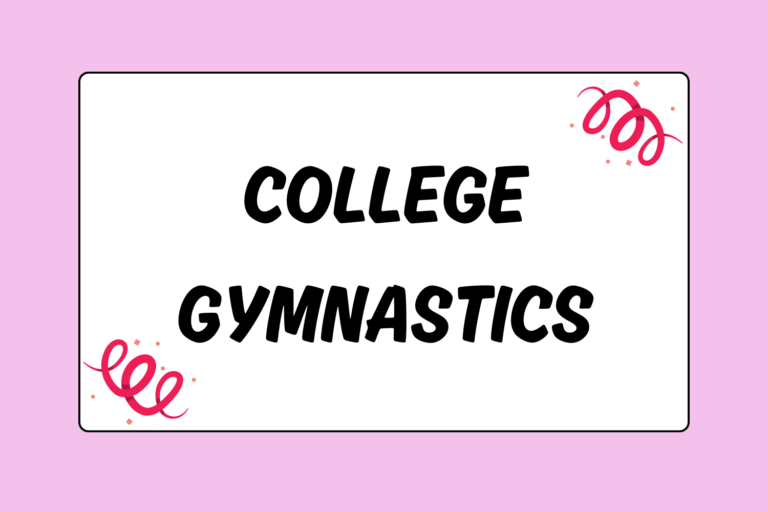The front handspring on floor is an important foundation for forward tumbling. Additionally, the skill carries over to the balance beam and vault. This gymnastics guide examines the handspring essentials, from the run and hurdle to the shoulder block and finish.
Run
A fast approach is crucial for building momentum.
Unlike running down the vault runway, your space is limited on the floor. Depending on your height, you may only fit in four to five steps. With such little room to run, each step matters, and it’s essential to increase your speed with each one.
Hurdle
The hurdle is the transitional skill between the run and the front handspring.
A hurdle is very similar to a skip. As you complete your run, you hop onto one foot, raising your dominant foot in the air. Some gymnasts find it easier to bend their dominant leg, while others keep both legs straight. Regardless, your arms should be over your head, keeping your shoulder angle open.
Your hurdle should be low and quick.
Lunge
Your dominant foot will reach forward as it returns to the floor.
At this point you’ll pass through the lunge position: Your dominant leg will bend — foot aligned with your knee — while your back leg stays straight behind you.
Hot Tip: It’s “T” Time
When you stand with your feet together, arms over your head, you’ll notice that your hands and feet are in a straight line. Now stand in a lunge with your arms up, leaning slightly forward. Your hands and back foot should still be in a straight line. As you lower your hands to the floor, your back leg should rise, never breaking the line. Think of this position as a seesaw, or a “T.” Maintaining this alignment is essential to performing a successful front handspring.
Heel Drive
As you pass through the lunge, your hands will reach to the floor. At the same time, your feet will rise off of the ground. The faster you lift, or drive, your heels off of the floor, the faster your front handspring will be.
Your feet should come together as your hands touch the ground. But heel drive doesn’t stop there; continue to force your feet over your head as you land in order to land properly.
Shoulder Block
Your hands have to leave the floor as soon as they first touch it. The longer you remain on your hands, the more likely it is that you’ll land on your bottom.
Here’s a tip: Raise your arms straight over your head while keeping your shoulders relaxed. Now raise your shoulders so that they’re touching your ears. This shrugging motion is, in fact, your block.
Now it’s time to block from your shoulders. While your hands are reaching for the floor, your arms should be extended and next to your head. At the same time your hands make contact with the floor, your shoulders should push toward your ears — effectively popping your hands off of the floor.
Landing
You should land the front handspring on the balls of your feet, with your arms above your head, and with your hands stretching behind you. Your eyes should be focused on your hands or the ceiling.
From this position, you’ll learn how to connect your front handspring to other skills, such as:
- A front tuck, pike, or layout.
- A bounder (front handspring with feet together on the take-off).
- Multiple front handsprings.
Front Handspring Drills
Your coach may have you practice the following drills:
- Front limber: You’ll kick into a handstand, then lower your feet to the floor and form a bridge. From the bridge, you’ll stand back up. The front limber mimics the motions of a front handspring.
- Heel drive against the wall: With a mat propped up on the wall, you’ll perform a handstand, driving your heels as quickly as possible into the mat.
- Handstand pop: To perfect your shoulder block, you’ll do a handstand and immediately hop your hands off of the floor, keeping your arms straight. If this drill becomes too easy, try multiple hops before your feet come down.
- Front handspring off of a springboard: You’ll follow the techniques outlined in this guide, but your hands will push off of a springboard. This drill gives you the feeling of blocking through your shoulders.
Fun Fact:
The front handspring on floor is required in the Level 5 and 6 floor routines. While Level 5 uses a single front handspring, the Level 6 floor routine contains a front handspring step-out — that is, landing one foot at a time — connected to a front handspring.
Finish
Now that you’re familiar with the necessary steps of the front handspring, it’s time to head to the gym and test your know-how. Remember to run hard, keep your hurdle fast and low, drive your heels, and block from the shoulders. Work on your “T” position and the drills your coach sets up for you, and you’ll be front handspringing in no time.





